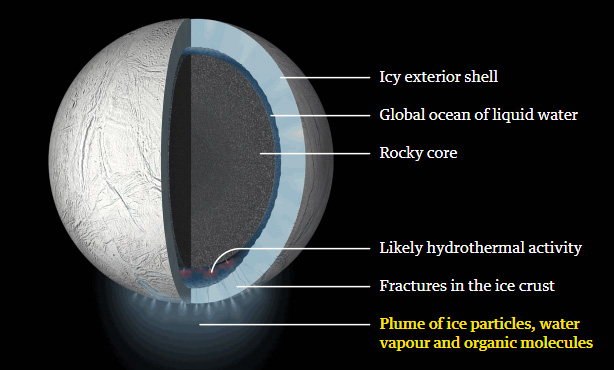
Plumes of water ice and vapour from the south polar region of Saturn’s moon Enceladus. Photograph: Nasa/AP
Deep-sea bacteria thrive in conditions designed to closely match those on Saturn’s tiny moon, Enceladus, according to scientists investigating the potential for alien life forms to survive there.
The findings are likely to intensify interest in Enceladus, which has risen to the top of the list of potential locations in our solar system that might have the right conditions to support extraterrestrial life. Last year Nasa announced that a flyby of Enceladus by the Cassini spacecraft had identified water, ice and most of the chemical ingredients necessary for habitability.
The Cassini spacecraft, which flew through a plume of vapour erupting from cracks in the moon’s icy surface, revealed the presence of hydrogen, which points to the existence of active energy sources on the moon’s ocean floor, similar to the hydrothermal vents that teem with life on Earth.
The microorganisms found on Earth, known as methanogenic archaea, use carbon dioxide and hydrogen as fuel and release methane as a byproduct. Traces of methane were also picked up by the Cassini probe, although it was impossible to tell whether these were linked to biological or geochemical reactions.
Enceladus sprays a constant plume of material into space from fractures at its south pole

Guardian graphic. Source & image: NASA/JPL-Caltech. Thickness of layers based on current understanding, as of Aug 2017
Now scientists have tested whether some of the microorganisms found in the Earth’s ocean vents, known as methanogens, could survive the conditions likely to be found on Enceladus. In theory at least, the scientists found they can.
Simon Rittmann, a biologist who led the work at the University of Vienna, said: “We’ve extended the boundaries within which we know methanogens can live.”
In designing the simulations, a challenge was the limited information about the conditions on Europa. Cassini’s observations show there is a liquid saltwater ocean, but scientists don’t know the ocean depth – which determines pressure – the temperatures around the vents and many details of the ocean chemistry.
So Rittmann and colleagues simulated a wide range of conditions, for instance varying pressure from three bars (shallow water) to 90bars (nearly 1km depth).
One of the deep-sea organisms tested, called Methanothermococcus okinawensis, thrived irrespective of the pressure, temperature, whether it was given vitamins or not and whether it was exposed to toxic chemicals such as formaldehyde, ammonia, or carbon monoxide. When placed in the most extreme conditions, the bacteria entered a state of dormancy, and reactivated within a couple of seconds once they were returned to a more favourable environment.
Hunter Waite, programme director for the space science and engineering division at the Southwest Research Institute in San Antonio, who led last year’s Cassini study, described the new simulations as a significant step forward – although he added that life on Enceladus, if it exists, would probably be quite different to that found on Earth. “I’m happy to see the progress and continued interest in this question,” he said.
In September, after 20 years in space, the Cassini probe plunged into Saturn’s atmosphere, where it was vaporised in a planned grand finale to the mission. There are currently no Saturn missions scheduled, meaning it will be at least a decade before another flyby of Enceladus can potentially answer some of the intriguing questions raised in the closing stages of the Cassini mission.
“It’s part of the reason to go back and start characterising the chemical conditions of the ocean with a flyby and better instruments,” said Waite. To definitively identify signs of past or present life on Enceladus would mean deploying a robotic space submarine, but “that’s not in our lifetime” Waite added.

 Previous page
Previous page Back to top
Back to top







